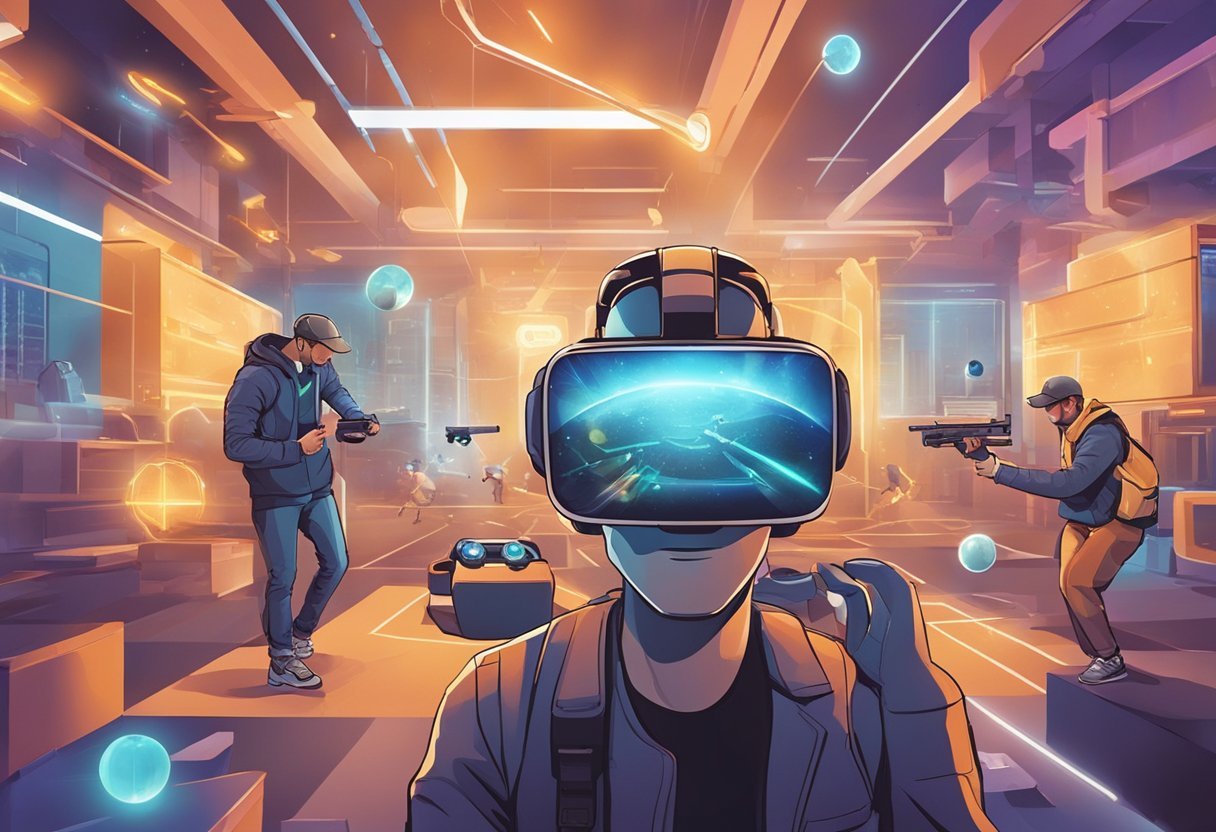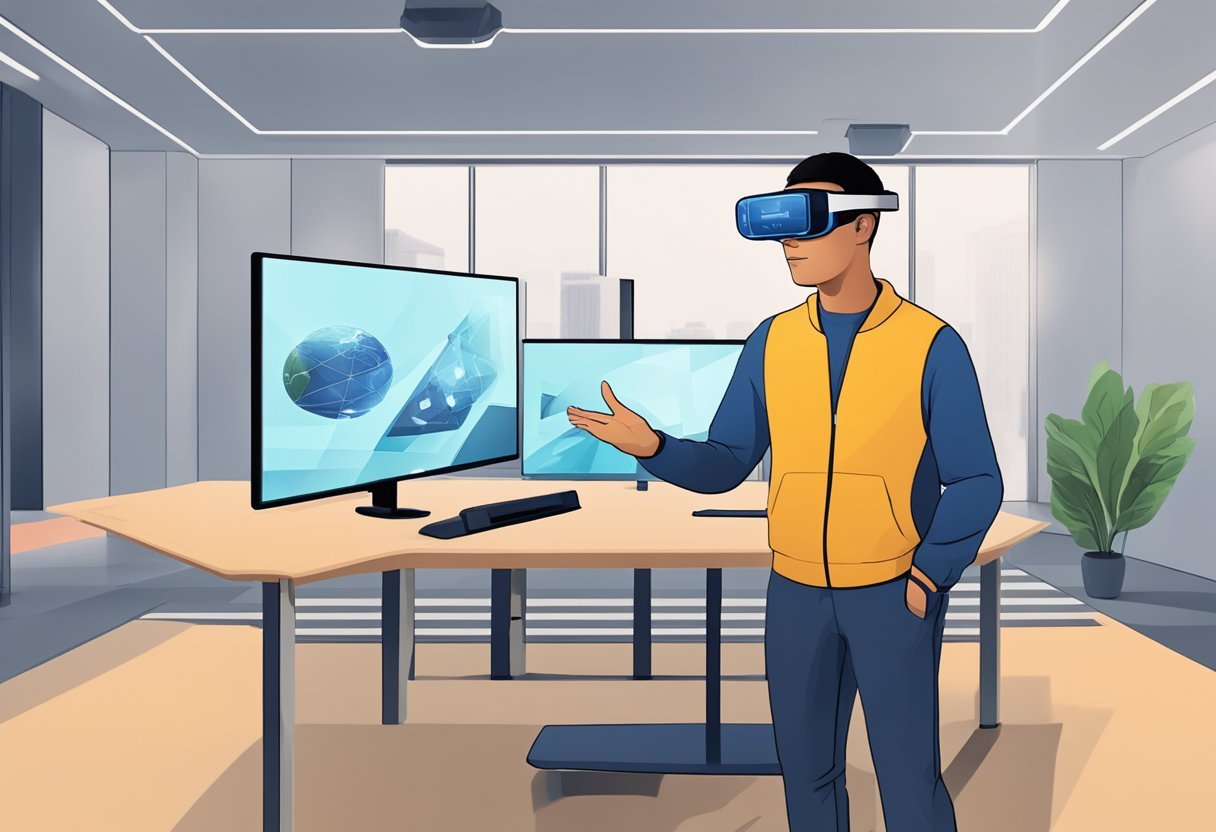Augmented gaming is a rapidly growing subfield of gaming that involves the integration of virtual game elements with the physical environment of the player. This technology allows gamers to experience an immersive gaming environment that blurs the line between the real world and the virtual world.
Augmented gaming works by overlaying digital content onto the real world, using technologies such as computer vision, GPS, and sensors to track the player’s movements and adjust the game accordingly. This technology can be used in a variety of gaming genres, from first-person shooters to puzzle games, and can be experienced through a variety of hardware, including smartphones, tablets, and AR headsets.
As the technology behind augmented gaming continues to evolve, we can expect to see new gameplay mechanics, user experiences, and hardware emerge. Software development for augmented gaming will become increasingly important as developers seek to create compelling and immersive gaming experiences. As the industry continues to grow, ethical considerations and privacy concerns will also need to be addressed.
Key Takeaways
- Augmented gaming integrates virtual game elements with the physical environment of the player.
- Augmented gaming works by overlaying digital content onto the real world using technologies such as computer vision, GPS, and sensors.
- As the industry continues to grow, we can expect to see new gameplay mechanics, user experiences, hardware, and ethical considerations emerge.
What Is Augmented Gaming
Augmented gaming is a type of gaming that combines the real world with the virtual world. It overlays digital content onto the real world, allowing players to interact with it in real-time. This type of gaming is made possible through the use of augmented reality (AR) technology.
AR technology uses a camera, sensors, and a display to create an interactive experience. It overlays digital images and information onto the real world, allowing players to see and interact with virtual objects as if they were real. AR technology has been around for some time, but it has only recently become mainstream, thanks to the popularity of mobile devices.
One of the benefits of augmented gaming is that it can be used to enhance the gaming experience. It allows players to experience games in a new and immersive way, making them feel like they are part of the game world. Augmented gaming can be used to create new types of games that would not be possible with traditional gaming technology.
Another benefit of augmented gaming is that it can be used to aid navigation in gaming. Players can find playing a game that involves exploring a new environment challenging without a guide. With AR technology, players can see a map of the game world overlaid onto the real world, making it easier to navigate.
How Augmented Gaming Works

Augmented reality (AR) gaming is a technology that overlays computer-generated graphics onto the real world. It uses a device’s camera to capture the real-world environment and then adds digital content to it. AR gaming is different from virtual reality (VR) gaming in that it does not require a headset or other specialized equipment.
To play an AR game, you need a device that supports AR technology, such as a smartphone or tablet. The device’s camera captures the real-world environment, and the AR software then overlays digital content onto it. The digital content can be anything from virtual characters to game elements, such as weapons or obstacles.
AR gaming is made possible by a combination of hardware and software. The hardware includes the device’s camera, sensors, and processors, while the software includes the AR engine and game engine. The AR engine is responsible for tracking the device’s movement and orientation, while the game engine is responsible for rendering the game content.
In AR gaming, the real-world environment becomes the game world. Players can interact with the game elements by moving around and manipulating the digital content. This creates a more immersive gaming experience than traditional gaming, as players are no longer limited to a screen.
Technologies in Augmented Gaming

Augmented Reality (AR) Platforms
Augmented reality (AR) platforms are essential to augmented gaming as they allow game developers to create and integrate virtual game elements with the physical environment of the player in real-time. AR platforms such as Apple’s ARKit and Google’s ARCore are becoming increasingly popular among game developers due to their ability to create immersive and interactive gaming experiences. These platforms use the camera and sensors on a smartphone or tablet to track the user’s movements and overlay virtual objects onto the real world.
Wearable Devices
Wearable devices such as smart glasses and head-mounted displays (HMDs) are also important technologies in augmented gaming. These devices allow players to experience the game in a more immersive way by overlaying virtual objects onto the real world. Wearable devices such as Microsoft’s HoloLens and Magic Leap’s One are popular among game developers due to their ability to create a more realistic gaming experience. These devices use advanced sensors and cameras to track the user’s movements and overlay virtual objects onto the real world.
Spatial Computing
Spatial computing is another important technology in augmented gaming. Spatial computing refers to the ability of a system to understand the physical world and its surroundings. This technology is essential to augmented gaming as it allows game developers to create more realistic and interactive gaming experiences.
Spatial computing technologies such as SLAM (Simultaneous Localization and Mapping) and LiDAR (Light Detection and Ranging) are becoming increasingly popular among game developers due to their ability to create more immersive and interactive gaming experiences.
These technologies are essential to augmented gaming as they allow game developers to create more immersive and interactive gaming experiences. Augmented reality platforms, wearable devices, and spatial computing technologies are becoming increasingly popular among game developers due to their ability to create more realistic and interactive gaming experiences.
Gameplay Mechanics in Augmented Gaming

Augmented reality (AR) gaming has brought about new gameplay mechanics that have revolutionized the gaming industry. In this section, we will discuss some of the gameplay mechanics that are unique to AR gaming.
Location-Based Gaming
Location-based gaming is a gameplay mechanic that utilizes the player’s real-world location to create an immersive gaming experience. This mechanic is made possible by the use of GPS technology, which allows the game to track the player’s location and provide them with location-based challenges and rewards.
Location-based gaming is particularly popular in mobile AR games, where players can explore their surroundings and interact with virtual objects and characters. This gameplay mechanic has been used in games such as Pokemon Go and Ingress, which have been successful in engaging players and creating social interactions.
Marker vs. Markerless AR
AR games can be classified into two categories: marker-based and markerless. Marker-based AR requires the use of a physical marker, such as a QR code or an image, to trigger the virtual content. On the other hand, markerless AR uses the player’s environment to trigger the virtual content.
Marker-based AR is more precise and accurate than markerless AR, as it relies on a physical marker to trigger the virtual content. However, markerless AR is more versatile and can be used in a wider range of environments.
Multiplayer and Social Interaction
Multiplayer and social interaction are essential gameplay mechanics in AR gaming. AR games that incorporate multiplayer and social interaction allow players to interact with each other in real-time and collaborate to achieve common goals.
Multiplayer and social interaction are made possible by the use of networked AR technology, which allows players to connect and interact with each other in real-time. This gameplay mechanic has been used in games such as Wizards Unite and Minecraft Earth, which have been successful in engaging players and creating social interactions.
AR gaming has brought about new gameplay mechanics that have revolutionized the gaming industry. Location-based gaming, marker vs. markerless AR, and multiplayer and social interaction are just a few of the gameplay mechanics that are unique to AR gaming. These mechanics have been successful in engaging players and creating social interactions, and we can expect to see more innovative gameplay mechanics in the future.
User Experience in Augmented Gaming
Augmented reality (AR) gaming is an immersive experience that combines virtual game elements with the physical environment of the player. To enhance user experience in augmented gaming, it is important to focus on user interface design, narrative and storytelling, accessibility, and inclusivity.
User Interface Design
User interface design plays a crucial role in creating an engaging augmented gaming experience. A well-designed interface can help players navigate the game easily and understand the game mechanics. It is important to keep the interface simple and intuitive, with clear instructions and feedback.
Designing an interface that is compatible with different devices and screen sizes is also important. The interface should be optimized for mobile devices, as most AR games are played on smartphones and tablets.
Narrative and Storytelling
Narrative and storytelling are important elements of augmented gaming that can enhance user experience. A well-crafted story can immerse players in the game world and motivate them to keep playing. A good story can also create a sense of purpose and meaning in the game.
To create an engaging narrative, it is important to consider the game’s target audience and their interests. The story should be consistent with the game mechanics and the game world, and should be presented in a way that is easy to follow.
Accessibility and Inclusivity
Accessibility and inclusivity are important considerations in creating an augmented gaming experience that is accessible to all players. It is important to design the game with features that make it accessible to players with different abilities and disabilities.
For example, the game should have options for players with color blindness or low vision. The game should also be designed to be playable with one hand, for players with mobility impairments. An engaging augmented gaming experience requires a well-designed user interface, a compelling narrative, and a focus on accessibility and inclusivity. By considering these factors, game developers can create an immersive and enjoyable experience for all players.
Augmented Gaming Hardware
When it comes to augmented gaming, hardware plays a crucial role in enhancing the experience. Here are some of the most common types of hardware used in augmented gaming.
Smart Glasses and Headsets
Smart glasses and headsets are becoming increasingly popular in augmented gaming. These devices allow you to see virtual objects overlaid onto the real world, creating a more immersive experience. Some popular examples of smart glasses and headsets include Microsoft HoloLens, Magic Leap, and Google Glass.
Haptic Feedback Devices
Haptic feedback devices provide tactile feedback to users, enhancing the sense of immersion in augmented gaming. These devices can be used to simulate the feeling of touching and interacting with virtual objects. Some popular examples of haptic feedback devices include the Teslasuit, HapYak, and the SenseGlove.
Motion Tracking Technology
Motion tracking technology is used to track the movements of the user and translate them into actions within the game. This technology is essential for creating a truly immersive augmented gaming experience. Some popular examples of motion tracking technology include the Leap Motion Controller, the Kinect Sensor, and the HTC Vive Tracker.
By using these hardware components, you can create an immersive augmented gaming experience that is sure to delight and engage users. Whether you’re a game developer or a gamer, investing in high-quality hardware is essential for creating and enjoying the best augmented gaming experiences.
Software Development for Augmented Gaming
Augmented reality (AR) gaming is an exciting field that requires careful consideration of software development. In this section, we’ll discuss the game engines and tools, programming languages, and development challenges that are important to consider when developing an AR game.
Game Engines and Tools
When it comes to developing an AR game, you’ll need to choose the right game engine and tools. Some popular options include Unity, Unreal Engine, ARKit, ARCore, Vuforia, and Wikitude. These game engines and tools provide developers with the framework for creating AR video game experiences. You can use these tools to create 3D models, animations, and other game assets, as well as to integrate AR features into your game.
Programming Languages
To develop an AR game, you’ll need to use programming languages such as C#, C++, or Java. These languages are used to write the code that brings your game to life. You may need to use specialized AR programming languages such as ARML or AR.js. It’s important to choose the right programming language for your needs and to have a good understanding of the language you choose.
Development Challenges
Developing an AR game can present unique challenges that you may not encounter when developing traditional video games. For example, you’ll need to consider the user’s physical environment and how it will affect the gameplay experience. You’ll also need to think about how to integrate real-world objects into your game and how to make the AR experience seamless and intuitive for the user. You’ll need to optimize your game’s performance to ensure that it runs smoothly on a variety of devices.
Developing an AR game requires careful consideration of game engines and tools, programming languages, and development challenges. By choosing the right tools and programming languages and by understanding the unique challenges of AR game development, you can create an engaging and immersive AR gaming experience.
Industry Impact and Trends

Market Growth
Augmented Reality (AR) gaming is a rapidly growing market that is estimated to reach USD million by 2030, with a CAGR of . AR technology has been embraced by the gaming industry and is transforming the way users experience games. The demand for AR gaming has been high, and industries using AR and VR technologies are expected to be valued at over $25 billion by 2025. The AR gaming market is expected to witness significant growth in the coming years, with the increasing adoption of AR technology in the gaming industry.
Emerging Business Models
AR gaming has opened up new business models for game developers, publishers, and advertisers. The integration of AR technology in games has enabled game developers to create more immersive and engaging gaming experiences for users.
AR technology has also enabled advertisers to create more interactive and engaging ad campaigns. AR gaming has opened up new revenue streams for game developers, publishers, and advertisers, and has created new opportunities for innovation and growth in the gaming industry.
Cross-Industry Applications
AR technology is not limited to the gaming industry and has cross-industry applications. AR technology has been adopted by industries such as healthcare, education, and retail, among others, to create immersive and engaging experiences for users.
AR technology has the potential to transform the way users interact with products and services, and has opened up new opportunities for innovation and growth in various industries. The adoption of AR technology is expected to increase in the coming years, as more industries realize the potential of AR technology to create immersive and engaging experiences for users.
The AR gaming market is witnessing significant growth, and the adoption of AR technology in the gaming industry has opened up new opportunities for innovation and growth. AR technology has also enabled game developers, publishers, and advertisers to create more immersive and engaging experiences for users. The cross-industry applications of AR technology are vast, and the adoption of AR technology is expected to increase in the coming years.
Ethical Considerations and Privacy
When it comes to augmented gaming, there are several ethical considerations that need to be taken into account. One of the most significant concerns is privacy. In this section, we will explore the different aspects of privacy that need to be considered when developing augmented games.
Data Security
Data security is a crucial aspect of privacy that needs to be considered when developing augmented games. Developers should ensure that the data collected from users is secure and protected from unauthorized access. This includes implementing strong encryption protocols and using secure storage methods. Developers should ensure that their systems are regularly audited to identify and address any vulnerabilities.
User Privacy
User privacy is another important consideration when developing augmented games. Developers should ensure that users have control over their personal information and that they are aware of how their data is being used. This includes providing users with clear and concise privacy policies and obtaining their consent before collecting any data. Developers should also ensure that users have the ability to delete their data at any time.
Regulatory Compliance
Finally, regulatory compliance is another important aspect of privacy that needs to be considered when developing augmented games. Developers should ensure that their games comply with all relevant privacy laws and regulations, such as the General Data Protection Regulation (GDPR) in the European Union. This includes obtaining the necessary permissions and consents from users, as well as providing them with the ability to access, modify, and delete their data.
Privacy is a significant ethical consideration when developing augmented games. Developers should ensure that they prioritize data security, user privacy, and regulatory compliance to protect their users’ personal information and maintain their trust.
Frequently Asked Questions
What are some prominent examples of augmented reality games?
Some of the most popular augmented reality games include Pokemon Go, Ingress, and Harry Potter: Wizards Unite. These games allow players to explore the real world while interacting with virtual objects and characters.
Which companies are leading in the development of augmented gaming technology?
Several companies are leading in the development of augmented gaming technology, including Niantic, the creator of Pokemon Go, and Unity Technologies, which provides a popular game engine for developing augmented reality games. Other companies like Apple and Google are also investing heavily in augmented reality technology.
How do augmented gaming apps enhance player experience?
Augmented gaming apps enhance player experience by providing a more immersive and interactive experience. Players can explore the real world while interacting with virtual objects and characters, making the gameplay more engaging and exciting.
What software is typically used to create augmented reality games?
There are several software tools used to create augmented reality games, including Unity, Unreal Engine, Vuforia, and ARKit. These tools provide developers with the necessary tools to create immersive and interactive augmented reality experiences.
How does augmented reality impact the gaming industry?
Augmented reality has the potential to revolutionize the gaming industry by providing new and exciting ways for players to interact with games. It allows players to explore the real world while interacting with virtual objects and characters, creating a more immersive and engaging experience.
What distinguishes augmented reality gaming from virtual reality gaming?
The main difference between augmented reality gaming and virtual reality gaming is that augmented reality games allow players to interact with virtual objects and characters in the real world, while virtual reality games create a completely virtual environment for players to explore. Augmented reality games are also typically played on mobile devices, while virtual reality games require specialized hardware like VR headsets.




